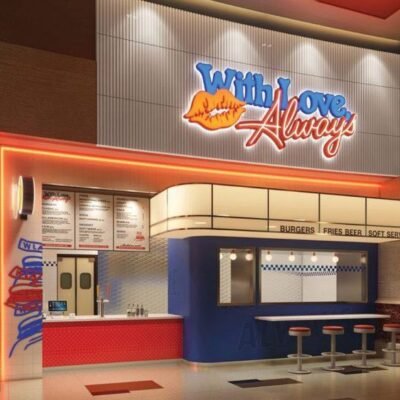1. Introduction: Vegas’s Next High-Flying Investment
Las Vegas, a city renowned for its continuous evolution, is once again poised for a transformative development that promises to reshape its entertainment landscape and, by extension, its real estate market. Beyond the glittering casinos and world-class shows, the city is increasingly embracing immersive, intellectual property (IP)-driven experiences, and a recent announcement exemplifies this strategic shift.
Paramount Global, in a significant partnership with Advent Allen Entertainment, has unveiled plans for an ambitious “Top Gun” themed immersive attraction, slated for a Summer 2028 debut. This is far more than just another ride; it represents a calculated move to leverage a globally beloved franchise into a multi-faceted entertainment destination designed for broad appeal.
This project underscores a fundamental change in how Las Vegas generates revenue and attracts visitors. The city is strategically moving away from a sole reliance on gaming-centric income towards diversified, experience-driven tourism. This pivot is evident in discussions within the entertainment industry, which indicate a “seismic shift” towards “immersive experiences over passive consumption,” with Las Vegas actively “de-emphasizing gaming in favor of entertainment experiences reportedly preferred by Millennials and Gen-Zers”. For the real estate market, this transition means that non-gaming revenue drivers are becoming increasingly vital for overall economic health, stability, and growth.
Furthermore, Paramount’s approach to this venture showcases a sophisticated strategy of IP monetization, often described as “real estate alchemy.” The company intends to “own the entire ecosystem—from intellectual property to real estate—ensuring profit flows from every angle”. This signifies a direct investment in physical real estate assets, driven by a blockbuster IP, suggesting a higher level of commitment and potential for long-term value creation compared to simple licensing agreements. This trend highlights how major media companies are increasingly becoming significant real estate developers themselves, directly influencing urban development.
This article will delve into the specifics of the “Top Gun Las Vegas” attraction, analyzing its anticipated economic impact and profound implications for both commercial and residential real estate across the Las Vegas Valley, with a particular focus on the North Strip area.
2. The Danger Zone to Development Zone: A New Vegas Landmark
The “Top Gun Las Vegas” attraction, currently a working title, is envisioned as a groundbreaking addition to the city’s entertainment offerings. It is described as a “revolutionary fusion of daring rides and cinematic storytelling,” promising to deliver one of the most adrenaline-charged, immersive experiences on the Las Vegas Strip.
The experience will feature state-of-the-art thrill ride systems and cutting-edge fighter jet simulators, designed to place guests directly into the high-octane world of “Top Gun.” Adding to the immersion, a full-scale recreation of “Top Gun: Maverick’s” iconic Hard Deck bar and restaurant will be a central feature, complete with live piano singalongs, allowing visitors to relive memorable cinematic moments. Paramount Global has also released concept art, providing a glimpse into the anticipated appearance of the attraction.
This ambitious project is strategically located on an undeveloped site at The STRAT Hotel, Casino & Tower, situated at 2000 Las Vegas Boulevard South. The STRAT itself is a prominent landmark, home to the tallest freestanding observation tower in the United States, standing at 1,149 feet. The anticipated launch date for the attraction is Summer 2028.
The venture is a collaborative effort between two significant entities: Paramount Global and Advent Allen Entertainment. Pam Kaufman, President and CEO of International Markets, Global Consumer Products and Experiences at Paramount, has highlighted Paramount’s dedication to delivering “authentic, mind-blowing experiences” for fans. Paramount has been actively expanding its presence in the tourism sector, with examples including Nickelodeon all-inclusive resorts in Mexico and Punta Cana, and an upcoming Nickelodeon resort in Orlando. On the other hand, Advent Allen Entertainment brings substantial expertise in high-concept destination experiences. Mark Advent, co-founder of Advent Allen Entertainment, is notably the creative force behind the legendary New York-New York Hotel & Casino, a project that significantly influenced Las Vegas’s era of theme-resort development. While Advent Allen’s broader portfolio includes various sports facilities and entertainment venues , the New York-New York Hotel & Casino is the most directly relevant large-scale entertainment development for this context. Looking beyond Las Vegas, plans are already being explored for future “Top Gun” attraction locations, both within the U.S. and internationally.
Table 1: “Top Gun Las Vegas” Attraction at a Glance
The choice of The STRAT, an established but somewhat isolated property on the North Strip, for this major attraction suggests a deliberate strategy to re-anchor and revitalize that specific part of the Strip. The site, currently undeveloped, has been identified as a “hidden gem”. Experts note that while “Las Vegas has long struggled with oversupply in certain areas,” Paramount’s project has the potential to “transform this plot into a must-see destination”. This indicates that the project is not merely about adding a new attraction, but about strategically transforming a specific, potentially underperforming, real estate asset and its surrounding area. The STRAT has also undergone significant renovations recently, including a $140 million upgrade, signaling a broader effort to modernize and attract a younger demographic. The “Top Gun” attraction is a major component of this larger revitalization, signaling a shift in investment focus towards the northern end of the Strip.
The detailed description of immersive technology, thrill rides, and interactive elements, such as live piano singalongs, points to a deep understanding of current consumer preferences. This is particularly true among Gen Z and Millennials, who increasingly prioritize experiences over traditional consumption. The project is designed to meet this demand with a mix of nostalgia and innovation, enhancing its likelihood of success and thus its positive real estate impact. This also suggests that future real estate developments in tourism-heavy areas will increasingly need to incorporate such immersive elements to remain competitive, creating a new benchmark for attraction-led real estate.
3. Soaring High: Economic Tailwinds for Las Vegas Real Estate
The “Top Gun Las Vegas” attraction is not merely an entertainment venue; it is envisioned as a powerful “three-pronged revenue machine”. This model projects significant income from high-margin ticket sales for its advanced simulators and rides, robust revenue from the Hard Deck bar and restaurant as a “cash cow” for premium cocktails and live entertainment, and substantial earnings from merchandise and licensing, including T-shirts, flight gear, and branded memorabilia. Paramount’s strategy to “own the entire ecosystem” from intellectual property to real estate ensures that profit flows from every angle, maximizing the economic benefit of the development.
This new attraction is anticipated to provide a significant boost to tourism and visitor numbers in Las Vegas. While recent figures from March 2025 indicated a slight drop in Nevada gaming revenue and Las Vegas Strip earnings, along with fewer tourists compared to the previous year , new attractions like “Top Gun” are crucial for reversing these trends and maintaining visitor momentum. Las Vegas, a city that thrives year-round, already draws 44 million annual visitors seeking novelty , and the “Top Gun” experience will offer a fresh, compelling draw. The investment in “Top Gun” comes at a time when Las Vegas gaming revenue has shown some recent struggles, indicating a strategic counter-cyclical investment. This move aims to diversify revenue streams and attract new visitor demographics, thereby stabilizing and growing the overall tourism economy. For the real estate market, this means that even if gaming faces headwinds, the experiential tourism sector can provide a buffer and continued demand for property, making the market more robust against single-sector downturns.
Large-scale entertainment developments are proven catalysts for job creation. Examples like Universal’s Epic Universe demonstrate that for every 1,000 jobs created within a theme park, an additional 700 jobs are generated off-site, creating a ripple effect throughout the community. The “Top Gun” attraction will undoubtedly require a significant workforce, including roles unique to the immersive entertainment industry, ranging from technical specialists for simulator maintenance to performers for the Hard Deck bar.
The strategic importance of IP-driven entertainment cannot be overstated. This project is hailed as a “masterstroke of thematic entertainment, IP-driven tourism, and real estate alchemy”. It leverages the enduring power of the “Top Gun” franchise, particularly following the global success of “Top Gun: Maverick,” which grossed $1.5 billion worldwide. This approach has a strong precedent; Disney’s Star Wars: Galaxy’s Edge, for instance, generated $1.5 billion in annual revenue for Disneyland alone. The “Top Gun” immersive experience could similarly become a “pilgrimage site” for fans, backed by Paramount’s global marketing machine. This transformation into a pilgrimage site implies a dedicated fan base willing to travel specifically for the experience, ensuring a consistent influx of visitors. This sustained demand directly translates into long-term stability and appreciation for surrounding real estate, as businesses catering to these visitors (retail, dining, accommodation) will thrive, extending the economic benefit beyond the initial launch buzz. Furthermore, Paramount’s existing IP portfolio, which includes popular franchises like Nickelodeon and SpongeBob, allows for the creation of a broader portfolio of themed experiences, spreading risk and boosting revenue. This showcases a scalable model for future development.
While industry giants like Disney and Universal often dominate headlines, Paramount is strategically leveraging its “underappreciated” IP to carve out a distinct niche in experiential entertainment. Paramount’s stock, with a lower P/E ratio compared to Disney, is considered “cheap relative to its growth potential”. This indicates that Paramount is not directly competing head-on with the sheer scale of Universal’s Epic Universe, but rather targeting a specific, high-margin segment with strong IP. This “blue ocean” approach in entertainment real estate could potentially offer higher returns on investment for early investors in the surrounding area, as the market is less saturated with similar offerings and the IP has proven global appeal.
4. Ground Control: Impact on Commercial Real Estate
The “Top Gun Las Vegas” attraction is set to be a significant catalyst for commercial real estate, particularly in its immediate vicinity on the North Strip. The STRAT site, currently an undeveloped parcel, is considered a “hidden gem”. Paramount’s project is expected to transform this plot into a “must-see destination”. This is a prime example of how IP-driven tourism can revitalize stagnant or underused real estate, showcasing a new model for urban redevelopment that leverages global entertainment brands to create tangible value.
The strategic placement of the attraction on the Strip, near existing casinos and hotels, is a key benefit. The constant foot traffic generated by the “Top Gun” experience will present a “golden opportunity for retail, hospitality, and entertainment venues to thrive”. This influx of visitors will drive increased demand for various commercial properties, including luxury retail spaces, gourmet restaurants, and other entertainment venues, not just within the attraction itself but also in the immediate surrounding area and extending outwards.
This project contributes to the broader trend of Las Vegas’s growing economy, which is led by tourism, gaming, and conventions and fuels consistent demand for commercial spaces. The average price per square foot for commercial real estate in Las Vegas is currently $460. The North Las Vegas area, adjacent to the Strip, is already experiencing an expanding commercial real estate market, indicating a ripple effect beyond the immediate attraction’s footprint. The “Top Gun” attraction acts as a significant catalyst for the long-anticipated revitalization of the North Strip, attracting further investment and development beyond the immediate project. The North Strip has historically lagged behind the central and south Strip in terms of new, high-profile developments. This attraction, combined with other potential projects, such as the proposed NBA-ready arena nearby , could create a critical mass of attractions, driving up commercial property values and demand for supporting businesses in an area that has been ripe for redevelopment. This could lead to a domino effect of new investments and a broader transformation of the northern end of the Strip.
The project embodies the concept of “real estate alchemy” by merging blockbuster intellectual properties with physical experiences to redefine entertainment and monetize franchises. It is presented as a blueprint for how Hollywood will monetize its franchises in the 2020s, suggesting a scalable and repeatable model that could influence future commercial real estate investments. Furthermore, the “three-pronged revenue machine” model (rides, food and beverage, and merchandise) suggests that commercial real estate investors can look beyond traditional retail or hospitality to specialized entertainment-support businesses. This creates distinct commercial real estate opportunities for investors in specific niches, such as spaces for high-tech entertainment support, specialized food and beverage concepts (beyond the Hard Deck bar itself), and retail outlets for branded merchandise. This diversification of commercial demand makes the area more resilient to fluctuations in any single sector, offering varied entry points for commercial real estate investment.
5. Landing Strip: Residential Real Estate Implications
The advent of major new attractions in Las Vegas, such as the “Top Gun” experience, has a discernible influence on residential property values and rental rates in nearby neighborhoods. In areas close to significant tourist draws, home prices and rental rates have seen noticeable increases, primarily due to the income potential offered by short-term leasing. Investors are actively targeting these areas, seeking to capitalize on the steady tourism traffic generated year-round.
The surge in demand for short-term rentals, facilitated by platforms like Airbnb and Vrbo, has created new income streams for property owners. This trend is particularly pronounced in popular areas such as the Las Vegas Strip, Henderson, and Downtown Las Vegas. Homeowners are increasingly converting second homes and investment properties into lucrative vacation rentals, a practice that is likely to intensify in neighborhoods surrounding the new “Top Gun” attraction.
Beyond direct rental income, tourism also drives broader urban growth and neighborhood revitalization. As resorts and attractions expand, there is a corresponding increase in the need for employee housing, services, and supporting infrastructure. This often leads to the revitalization of older neighborhoods and increased demand for residential properties near employment hubs. Areas like Paradise, Spring Valley, and North Las Vegas have already experienced development surges, reflecting the broader impact of tourism-driven growth. The success of sports tourism, with the arrival of professional teams like the Vegas Golden Knights and the Raiders, has also contributed to a housing boom, setting a precedent for how new attractions can stimulate residential market growth.
For real estate investors and homeowners, the Las Vegas housing market currently presents a stable and appreciating environment. The median home price in Las Vegas stands at $420,000, reflecting a 2.9% year-over-year increase, with homes selling quickly, averaging just 37 days on the market. North Las Vegas, offering more affordable inventory, has seen its median home prices rise by 3.8% year-over-year to $370,000, driven by increased interest in affordable housing and expanded infrastructure. Average rent prices across Las Vegas have also increased by 4.1% year-over-year, indicating a robust rental market that benefits from sustained demand.
Table 2: Real Estate Impact Snapshot
The job creation associated with the “Top Gun” attraction and other new developments will intensify the demand for affordable and mid-tier residential housing, particularly in areas accessible to the North Strip. As resorts expand, there is a clear “need for employee housing” , which drives development surges in areas like Paradise, Spring Valley, and North Las Vegas. North Las Vegas, in particular, offers “some of the most affordable inventory” and has seen its appreciation driven by increased interest in affordable housing and expanded infrastructure. This indicates a direct causal link: new entertainment jobs create demand for housing for the workforce, which will likely push up prices and rents in more affordable, accessible neighborhoods, presenting specific investment opportunities for those targeting the long-term rental market rather than just short-term vacation rentals.
However, the expected surge in short-term rentals due to increased tourism will likely lead to heightened regulatory scrutiny, impacting investor strategies. While the potential for income from short-term rentals is attractive , local governments in Nevada have already introduced regulations on short-term rentals to balance tourism benefits with the rights and comfort of permanent residents. Licensing requirements, occupancy limits, and zoning laws are common across the state and can evolve. This means that while the attraction boosts tourism, the real estate play isn’t as simple as acquiring any property and listing it on a short-term rental platform; regulatory nuances must be considered and factored into investment models to avoid legal pitfalls or reduced profitability.
6. Navigating the Turbulence: Potential Challenges & Considerations
While the “Top Gun Las Vegas” attraction presents significant opportunities, it is essential to acknowledge potential challenges and considerations that could impact its development and subsequent real estate implications.
One primary risk involves execution delays. Large-scale construction and complex technology integration, common in projects of this magnitude, can face unforeseen snags, as has been observed with Universal’s recent park delays. Although the planned 2028 launch date allows for a three-year buildout, which provides time to perfect the IP integration and avoid rushed launches , this extended timeline also lengthens the period of vulnerability to unforeseen economic shifts, supply chain issues, or changes in consumer preferences. This means that while the long-term outlook is positive, the immediate real estate investment near the site might experience a period of uncertainty until the attraction’s opening, as speculative gains could be delayed or dampened by external factors.
Another consideration is brand appeal and its potential to fade. Relying heavily on the “Top Gun” legacy carries a risk if the franchise’s appeal wanes over time. However, the phenomenal success of “Top Gun: Maverick,” which grossed $1.5 billion worldwide, strongly demonstrates the franchise’s enduring staying power and emotional resonance with audiences, mitigating this risk to a considerable extent.
Furthermore, broader economic uncertainty remains a factor. Macroeconomic headwinds, consumer uncertainty, and even a slump in air travel can impact theme park visitation. Recent dips in Las Vegas gaming revenue, with fewer tourists reported in March 2025, highlight the city’s sensitivity to economic fluctuations. Even diversified entertainment attractions are not entirely immune to economic downturns, underscoring the need for a resilient market.
The regulatory landscape poses another dynamic challenge. While new attractions drive economic growth, balancing tourism growth with community concerns is crucial, particularly regarding the proliferation of short-term rentals. Licensing requirements, occupancy limits, and evolving zoning laws are common across Nevada, and these regulations can shift, requiring investors in the residential sector to remain agile and well-informed.
Finally, market competition in Las Vegas is intense. The city is a highly competitive hub for attractions and entertainment venues. Universal, a major player, is also expanding its theme park business, with a Hollywood Horror Nights experience planned for Las Vegas later this year and the Epic Universe opening in Orlando. Disney, too, has pledged a substantial $60 billion over a decade to improve, innovate, and expand its amusement locations. This robust competition sparks continuous innovation to create more compelling attractions , meaning the “Top Gun” attraction will need to consistently deliver a high-quality, engaging experience to maintain its draw and competitive edge.
The increasing cost of entertainment and living in Las Vegas could create a tension between attracting visitors and maintaining affordability for residents and workers. Theme park tickets can be expensive, potentially costing “a thousand dollars or more for a multiday visit” for a family, indicating a premiumization of the entertainment experience. Concurrently, residential real estate prices and rents are rising , and there is a recognized “need for employee housing” as resorts expand. This creates a potential long-term friction: if the cost of living outpaces wage growth for the service industry workers who staff these attractions, it could lead to labor shortages or social pressures. This, in turn, could indirectly impact the operational efficiency and long-term sustainability of new developments, making it a subtle but important long-term consideration for urban planners and real estate developers.
7. Conclusion: A Maverick Move for Vegas Real Estate
The planned “Top Gun Las Vegas” attraction represents a significant and strategic investment in the city’s evolving entertainment landscape. It is poised to be a powerful engine for economic growth, driving increased tourism, creating numerous jobs, and catalyzing real estate appreciation, particularly within the North Strip area. This project underscores the growing importance of IP-driven experiential tourism in shaping urban development, providing a new blueprint for how major entertainment franchises can translate into tangible real estate value.
Las Vegas continues to demonstrate its remarkable resilience and adaptability. Investments like the “Top Gun” attraction, coupled with other major developments across the valley, reinforce its position as a dynamic and attractive market for real estate. The city’s strategic shift towards diversified entertainment experiences provides a more stable and appealing long-term outlook for investors, moving beyond its traditional reliance on gaming revenue.
For real estate investors, agents, and homeowners, understanding these evolving trends is paramount. Opportunities abound in both the commercial and residential sectors, ranging from lucrative short-term rentals near the Strip to the growing demand for workforce housing in developing neighborhoods. As the experts suggest, it is time to “strap in,” because this development represents a “jet-powered opportunity to ride the next wave of entertainment innovation” in the Las Vegas real estate market.
Houses that are priced, presented & marketed correctly are selling fast.
Let my 34+ years of Real Estate experience in Las Vegas work for you. 702-378-7055
The information contained, and the opinions expressed, in this article are not intended to be construed as investment advice. Very Vintage Vegas does not guarantee or warrant the accuracy or completeness of the information or opinions contained herein. Nothing herein should be construed as investment advice. You should always conduct your research and due diligence and obtain professional advice before making any investment decision. Very Vintage Vegas, will not be liable for any loss or damage caused by your reliance on the information or opinions contained herein.





